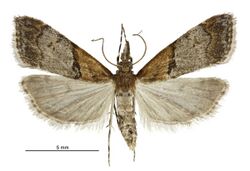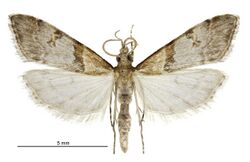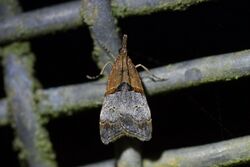Biology:Antiscopa epicomia
| Antiscopa epicomia | |
|---|---|

| |
| Female | |

| |
| Male | |
| Scientific classification | |
| Domain: | Eukaryota |
| Kingdom: | Animalia |
| Phylum: | Arthropoda |
| Class: | Insecta |
| Order: | Lepidoptera |
| Family: | Crambidae |
| Genus: | Antiscopa |
| Species: | A. epicomia
|
| Binomial name | |
| Antiscopa epicomia (Meyrick, 1884)[1]
| |
| Synonyms[2] | |
| |
Antiscopa epicomia is a moth in the family Crambidae.[1] This species was first described by Edward Meyrick. It is endemic to New Zealand and can be found throughout the country including on Auckland Island, Campbell Island, and the Kermadec Islands. It inhabits native forest, preferring damp, shaded forest ravines. Adults are variable in size and colouration and are on the wing all year but most frequently from October until March.
Taxonomy
It was described by Edward Meyrick in 1884 from specimens collected amongst native bush in January and obtained near Arthur's Pass and Dunedin and named Scoparia epicomia.[3][4] In 1928 George Hudson discussed and illustrated this species in his book The butterflies and moths of New Zealand.[5] In 1964 E. Munroe placed this species in the genus Antiscopa.[6] This placement was followed by J. S. Dugdale in 1988.[7] The male lectotype, collected in Dunedin, is held at the Natural History Museum, London.[7]
Description
The wingspan is 18–19 mm. The forewings are pale light ochreous grey, but the basal third is reddish-ochreous brown. The hindwings are pale whitish grey with a light grey lunule, postmedian line and submarginal band.[4]
This species varies in size as well as in the colour and intensity of its markings.[5] Specimens obtained in the north tend to be brighter marked than those collected in the south of the country.[5] A. epicomia is superficially very similar to S. fimbiata but the latter can be distinguished as the male has antennal pectinations.[5]
Distribution
A. epicomia is endemic to New Zealand.[8] It can be found throughout New Zealand, including on Auckland Island, Campbell Island and on the Kermadec Islands.[9][5] It has been observed at altitudes ranging from sea-level to 1150m.[5]
Behaviour
Adults have been observed on wing all year but are more frequently seen from October to March.[10][5] This species is attracted to light as well as UV light.[11]
Habitat
This species inhabits native forest and has been observed in damp, shaded forest ravines.[5]
References
- ↑ 1.0 1.1 Gordon, Dennis P., ed (2010). New Zealand Inventory of Biodiversity. Volume Two. Kingdom Animalia: Chaetognatha, Ecdysozoa, Ichnofossils. 2. Christchurch, N.Z.: Canterbury University Press. pp. 458. ISBN 9781877257933. OCLC 973607714. https://www.worldcat.org/oclc/973607714.
- ↑ "Antiscopa epicomia (Meyrick, 1884) - Biota of NZ". https://biotanz.landcareresearch.co.nz/scientific-names/7232b656-bb23-4352-810e-fe507573da2f.
- ↑ Meyrick, Edward (September 1884). "Supplement to a monograph of the New Zealand Geometrina". New Zealand Journal of Science 2: 234–237. https://www.biodiversitylibrary.org/page/41863307.
 This article incorporates text from this source, which is in the public domain.
This article incorporates text from this source, which is in the public domain.
- ↑ 4.0 4.1 Meyrick, Edward (May 1885). "Descriptions of New Zealand Micro-lepidoptera". Transactions and Proceedings of the New Zealand Institute 17: 68–120. https://www.biodiversitylibrary.org/page/33934529.
- ↑ 5.0 5.1 5.2 5.3 5.4 5.5 5.6 5.7 , pp. 194-195, Wikidata Q58593286
- ↑ , Wikidata Q115118913
- ↑ 7.0 7.1 , pp. 152, Wikidata Q45083134
- ↑ "Antiscopa epicomia (Meyrick, 1884)". Landcare Research New Zealand Ltd. 23 December 2014. http://www.nzor.org.nz/names/475cb694-72bd-493b-ac0b-0e3ec1fef072.
- ↑ , pp. 115, Wikidata Q54583729
- ↑ "Antiscopa epicomia" (in en). https://www.inaturalist.org/taxa/385789-Antiscopa-epicomia.
- ↑ Littlejohn, Jacob (2023-01-08). "Antiscopa epicomia" (in en). https://www.inaturalist.org/observations/146097019.
Wikidata ☰ Q13380539 entry
 |


